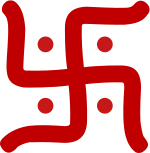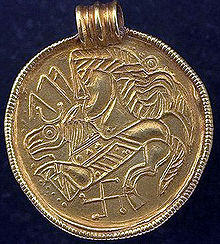Svastika

D Svastika oder Swastika (Sanskrit: स्वस्तिक svastika m. »Glückszaiche«) und uf tütsch Hooggechrüüz isch e weltwiit verbraitets und en uralts Zaiche i Chrüzform mit abgwinklete Endi. D Verbraitig goot vo Europa und Nordafrika öber Asie bis uf Mittelamerika. Di ältiste Darstelige vom Hoogechrüüz stamet us Mesopotamie und wered is 4. Joortuusig v. Chr. datiert. In Mitteleuropa taucht d Svastika zerstmol i de Bandkeramik-Kultur uuf.
Wil s Hooggechrüz s Symbol vom dütsche Nationalsozialismus gsi isch, isch s bis hüte e Symbol, wo mit em Rächtsextremismus, Rassismus und Antisemitismus identifiziert wird. Z Dütschland isch s Dräge vom Hooggechrüz wäge däm verbote.
Näme
[ändere | Quälltäxt bearbeite]Wege de wiite Verbraitig het s Hooggechrüüz fill Näme. De Sanskritname svastika isch en Ablaitig vo skt. svasti f. »Glück, Hail«. De tütsch Name Hoogechrüüz bizücht sich uf di üsseri Form und isch en Öbersetzig vo Latinisch crux grammata. Bi de Angelsachse het s fylfōt »Fülifuess« ghaisse.
Indie
[ändere | Quälltäxt bearbeite]D Svastika isch im Hinduismus und im Jinismus e Glückssymbol, wo i de Kunst hüüffig bruucht werd. A bestimmte Aaläss werd da Zaiche au mit Chride uf Weg und Hüser gmoolet. Denebet bizaichnet Svastika ono s Chrüüze vo de Händ vor de Brust. Im Yoga isch s Svastikasana e Sitzstelig mit gchrüüzte Bai und im Ayurveda, de traditionelle indische Mediziin, cha Svastika au de Chrüzverband maine.
Im Jinismus het da Zaiche e hööche Wert und da Zaiche taar i kaim Buech und kaim Tempel feele. Im Gottesdienst wered um de Altoor Svastika us Riis gstroilet. D Svastika isch au s Symbol vom 7. Tirthamkara Suparshva und anderne Jainahailige.
Antiki
[ändere | Quälltäxt bearbeite]S Hooggechrüüz isch z Griecheland sit de minoische Zitt bizügt. Wääred de geometrische Phase isch s Hooggechrüüz e biliebts Sujet uf Keramikgschier.
Germane
[ändere | Quälltäxt bearbeite]
Bi de Germane isch d Svastika ebefalls guet bizügt und chunnt hüüffig uf nordgermanische Brakteate us de Völkerwanderigszitt vor.
Literatur
[ändere | Quälltäxt bearbeite]- Historischi Werk
- Robert Philips Greg: On the Meaning and Origin of the Fylfot and Swastika. Nichols & Sons, Westminster 1884. Nachdruck: Kessinger Publishing, Whitefish MT 2008, ISBN 978-1-4370-2393-0.
- Alois Raimund Hein: Mäander, Kreuze, Hakenkreuze und urmotivische Wirbelornamente in Amerika. Ein Beitrag zur allgemeinen Ornamentgeschichte. Alfred Hölder, Wien 1891.
- Thomas Wilson: Swastika. The Earliest Known Symbol and Its Migrations. With Observations on the Migration of Certain Industries in Prehistoric Times. In: Report of the United States National Museum 1894, ISSN 0273-0243, S. 757–1011. Nochdruck: Kessinger Publishing Co., Whitefish MT 1999, ISBN 0-7661-0818-X. Online uf www.northvegr.org
- Albert Churchward: Early Masonic Symbolism and Its Ancient Origins. The Gavel, Three Pillars, Masonic Signs, and Swastika. In: Albert Churchward: Signs and Symbols of Primordial Man. The Signs and symbols of primordial man. Being an explanation of the evolution of religious doctrines from the eschatology of the ancient Egyptians. Sonnenschein u. a., London 1910, S. 6–28. (Nochdruck: Kessinger Publishing Co., Whitefish MT 2005, ISBN 1-162-82968-0)
- Hans Georg Wackernagel: Hakenkreuz im Mittelalter. In: Schweizer Volkskunde. Jg. 29, 1939, S. 13–14.
- Englisch
- Malcolm Quinn: The Swastika: Constructing the Symbol (Material Cultures). Routledge Chapman & Hall, 1995, ISBN 0-415-10095-X.
- Steven Heller: The Swastika. Symbol Beyond Redemption? Allworth Press, New York 2000, ISBN 1-58115-041-5.
- Egbert Richter-Ushanas: The Sacred Marriage and the Swastika on Indus Seals and Tablets. A study on the foundations of human culture. Richter, Bremen 2005, ISBN 3-924942-42-0.
- Bernard Mees: The Science of the Swastika. Central European University Press, 2008, ISBN 978-963-9776-18-0.
- Erwin W. Lutzer: Hitler's Cross. Bertrams, 2012, ISBN 978-0-8024-0850-1.
- Französisch
- Bernard Marillier: Le Svastika. Pardès, Puiseaux 1997, ISBN 2-86714-153-2.
- Jacques Gossart: La longue marche du svastika. Histoire connue et inconnue de la croix gammée. Dervy, Paris 2002, ISBN 2-84454-202-6.
- Dütsch
- Arnold Rabbow: Hakenkreuz. In: dtv-Lexikon politischer Symbole. A–Z. Deutscher Taschenbuch-Verlag, München 1970, S. 110–118.
- Lorenz Jäger: Das Hakenkreuz. Zeichen im Weltbürgerkrieg. Eine Kulturgeschichte. Karolinger-Verlag, Wien 2006, ISBN 3-85418-119-1.
- Elisabeth Weeber: Das Hakenkreuz. Geschichte und Bedeutungswandel eines Symbols. Peter Lang, Frankfurt am Main 2007, ISBN 978-3-631-56363-2.
Weblink
[ändere | Quälltäxt bearbeite]- Gschicht